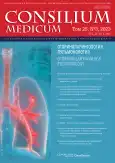Functional disorders of the respiratory system in combat chest injury
- Authors: Savushkina O.I.1, Astanin P.A.2,3, Malashenko M.M.1, Pyhtin I.V.1, Kuzmina E.R.1, Zaitsev A.A.1,4
-
Affiliations:
- Burdenko Main Military Clinical Hospital
- Pirogov Russian National Research Medical University
- Izmerov Research Institute of Occupational Health
- BIOTECH University
- Issue: Vol 25, No 3 (2023): Otorhinolaryngology and pulmonology
- Pages: 213-217
- Section: Articles
- URL: https://journals.rcsi.science/2075-1753/article/view/131683
- DOI: https://doi.org/10.26442/20751753.2023.3.202191
- ID: 131683
Cite item
Full Text
Abstract
Background. Gunshot injuries occupy one of the leading places in a number of injuries (combat injuries) that occur in military conflicts.
Aim. To study the effect of gunshot wounds of the chest (penetrating and non-penetrating), as well as closed chest trauma on the respiratory function.
Materials and methods. The study included 78 patients with a diagnosis of combined trauma, including a gunshot penetrating/non-penetrating wound of the chest or closed chest injuries. The median period from injury to the time of lung function tests was 17 [15; 22] days.
Results. A prospective cross-sectional study was performed. All patients (100% males) underwent spirometry, body plethysmography, and diffusion test. The total sample was divided into two groups: group 1 (median age 27.5 [23.0; 36.0] years) – 68 patients with gunshot penetrating chest wound, group 2 (median age 26.5 [20.0; 30.5] years) – 10 patients with gunshot non-penetrating wound or closed chest trauma. In group 1, the medians of the vital capacity, forced vital capacity, inspiratory capacity, forced exhalation volume in 1 second, lung diffusion capacity (determined by the value of the carbon monoxide transfer-factor – DLCO) and alveolar volume were reduced. In group 2, pulmonary ventilation parameters were within normal values while the median of DLCO was reduced. There were no statistically significant differences between the groups.
Conclusion. Both gunshot penetrating wounds of the chest and gunshot non-penetrating wounds of the chest and closed chest injuries have a negative impact, including on the respiratory function, to a greater extent on lung diffusion capacity. It is necessary to create programs of drug correction and longer rehabilitation treatment of this category of patients.
Full Text
##article.viewOnOriginalSite##About the authors
Olga I. Savushkina
Burdenko Main Military Clinical Hospital
Email: olga-savushkina@yandex.ru
ORCID iD: 0000-0002-7486-4990
Cand. Sci. (Biol.), Burdenko Main Military Clinical Hospital
Russian Federation, MoscowPavel A. Astanin
Pirogov Russian National Research Medical University; Izmerov Research Institute of Occupational Health
Email: med_cyber@mail.ru
ORCID iD: 0000-0002-1854-8686
Graduate Student, Pirogov Russian National Research Medical University, Izmerov Research Institute of Occupational Health
Russian Federation, Moscow; MoscowMaria M. Malashenko
Burdenko Main Military Clinical Hospital
Email: mar-malashenko@yandex.ru
ORCID iD: 0000-0002-8204-6269
Cand. Sci. (Med.), Burdenko Main Military Clinical Hospital
Russian Federation, MoscowIgor V. Pyhtin
Burdenko Main Military Clinical Hospital
Email: gvkg@mil.ru
Deputy Head of Medical Supply, Burdenko Main Military Clinical Hospital
Russian Federation, MoscowEkaterina R. Kuzmina
Burdenko Main Military Clinical Hospital
Email: damietta@mail.ru
Cand. Sci. (Med.), Burdenko Main Military Clinical Hospital
Russian Federation, MoscowAndrey A. Zaitsev
Burdenko Main Military Clinical Hospital; BIOTECH University
Author for correspondence.
Email: a-zaicev@yandex.ru
ORCID iD: 0000-0002-0934-7313
D. Sci. (Med.), Prof., Burdenko Main Military Clinical Hospital, BIOTECH University
Russian Federation, Moscow; MoscowReferences
- Самохвалов И.М., Гаврилин С.В., Супрун А.Ю., и др. Роль ушиба легких в патогенезе дыхательных расстройств при тяжелой сочетанной травме груди. Вестник анестезиологии и реаниматологии. 2011;8(5):11-6 [Samokhvalov IM, Gavrilin SV, Suprun AYu, et al. The role of pulmonary contusion in the pathogenesis of respiratory disorders in severe concomitant chest trauma. Vestnik Anesthesiology and Resuscitation. 2011;8(5):11-6 (in Russian)].
- Крюков Е.В., Чуприна А.П., Зайцев А.А. Травма груди. В: Респираторная медицина. М., 2017. Т. 3. С. 174-81 [Kryukov EV, Chuprina AP, Zaitsev AA. Travma grudi. In: Respiratornaia meditsina. Moscow, 2017. Vol. 3. P. 174-81 (in Russian)].
- Методическое руководство: Спирометрия. Российское респираторное общество. 2023. Режим доступа: https://spulmo.ru. Ссылка активна на 10.02.2023 [Spirometry. Methodological guide. Russian respiratory society. 2023. Available at: https://spulmo.ru. Accessed: 10.02.2023 (In Russian)].
- Wanger J, Clausen JL, Coates A, et al. Standardisation of the measurement of lung volumes. Eur Respir J. 2005;26(3):511-22. doi: 10.1183/09031936.05.00035005
- Graham BL, Brusasco V, Burgos F, et al. 2017 ERS/ATS Standards for single-breath carbon monoxide uptake in the lung. Eur Respir J. 2017;49(1):1600016. doi: 10.1183/13993003.00016-2016
- Graham BL, Steenbruggen I, Miller MR, et al. Standardization of Spirometry 2019 Update. Am J Respir Crit Care Med. 2019;200(8):70-88. doi: 10.1164/rccm.201908-1590ST
- Pellegrino R, Viegi G, Brusasco V, et al. Interpretative strategies for lung function tests. Eur Respir J. 2005;26(5):948-68. doi: 10.1183/09031936.05.00035205.
- Каменева М.Ю. Синдром нарушения легочного газообмена у больных интерстициальными заболеваниями легких. Бюллетень физиологии и патологии дыхания. 2015;56:14-20 [Kameneva MYu. Syndromes of gas exchange abnormalities in patients with interstitial lung diseases. Bulletin Physiology and Pathology of Respiration. 2015;56:14-20 (in Russian)].
- Cohn S, Dubose JJ. Pulmonary contusion: an update on recent advances in clinical management. World J Surg. 2010;34(8):1959-70. doi: 10.1007/s00268-010-0599-9
- Савушкина О.И., Зайцев А.А., Малашенко М.М., и др. Функциональные нарушения системы дыхания у пациентов с проникающими ранениями легких: дизайн проспективного исследования. Consilium Medicum. 2022;24(3):199-204 [Savushkina OI, Zaytsev AA, Malashenko MM, et al. Functional disorders of the respiratory system in patients with penetrating lung wounds: study prospective design. Consilium Medicum. 2022;24(3):199-204 (in Russian)]. doi: 10.26442/20751753.2022.3.201527
Supplementary files






